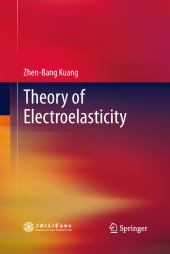 Neuerscheinungen 2015Stand: 2020-02-01 |
Schnellsuche
ISBN/Stichwort/Autor
|
Herderstraße 10
10625 Berlin
Tel.: 030 315 714 16
Fax 030 315 714 14
info@buchspektrum.de |

Zhen-Bang Kuang
Theory of Electroelasticity
Softcover reprint of the original 1st ed. 2014. 2015. ix, 431 S. 235 mm
Verlag/Jahr: SPRINGER, BERLIN; SPRINGER BERLIN HEIDELBERG 2015
ISBN: 3-642-43077-5 (3642430775)
Neue ISBN: 978-3-642-43077-0 (9783642430770)
Preis und Lieferzeit: Bitte klicken
This book analyzes the stress, strain, electric field and electric displacement in electroelastic structures such as sensors, actuators and other smart materials and structures. Describes the physical variational principle and the inertial entropy theory.
Theory of Electroelasticity analyzes the stress, strain, electric field and electric displacement in electroelastic structures such as sensors, actuators and other smart materials and structures. This book also describes new theories such as the physical variational principle and the inertial entropy theory. It differs from the traditional method by using the physical variational principle to derive the governing equations of the piezoelectric material, whereas the Maxwell stress is obtained automatically. By using the inertial entropy theory, the temperature wave equation is obtained very easily.
The book is intended for scientists, researchers and engineers in the areas of mechanics, physics, smart material and control engineering as well as mechanical, aeronautical and civil engineering, etc.
Zhen-Bang Kuang is a professor at Shanghai Jiao Tong University.
Introduction Continuum Thermodynamics.- Physical variational Principle and Governing Equations.- Generalized two dimensional electroelastic problem.- Linear inclusion and related problems.- Some problems in more complex materials with deffects.- Electroelastic wave.- Three dimensional and applied electroelastic problem.- Failure theory in piezoelectric materials.
"The book represents a panoramic review of electroelasticity, including the theoretical basis, as well as numerous applications to piezoelectrics and pyroelectrics. This is based in many parts on own research work by the author and collaborators, and is intended for a large audience of readers with interest in the subject. The book has eight chapters, with a list of references at the end of each." (Ahmed Ghaleb, zbMATH 1323.74002, 2015)


